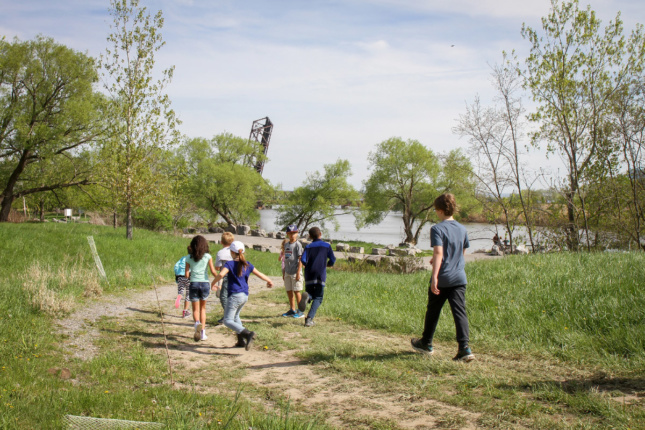A competition to revitalize a 1.5-mile-long elevated railway in Buffalo, New York, has ended with five winners, and all five proposals will be combined to shape an RFP aimed at breathing new life into the abandoned rail corridor.
The Western New York Land Conservancy launched the Reimagining the DL&W Corridor: International Design Ideas Competition in November of 2018 to revive an abandoned stretch of the Delaware, Lackawanna and Western (DL&W) railway that runs from Canalside to the Solar City plant. Much like the High Line or the proposed QueensWay in the southern half of the state, the DL&W railway will be turned into an elevated park that will unite formerly-industrial neighborhoods with a continuous rewilded landscape.
“Reclaiming Hill & Del” from the New York City–based Mathews Nielsen Landscape Architects (MNLA) took first prize. Their ambitious proposal turns the corridor into an all-season multimodal path to the Buffalo River, using the varied topography of the ridge to add excitement to the routes. Native plants would be used to return the path to a state of nature.
“The Dell, The Link & The Wanderer (DLW),” a collaboration between Marvel Architects, BuroHappold, horticulturalist and landscape architect Patrick Cullina, and graphic and placemaking studio NOWHERE Office took second place. The DLW would divide the railway into several distinct ecologies while threading through the neighborhoods. The Dell portion would bring secluded, wooded areas to the former rail line; the Link is where the new park would integrate with existing streets at grade; and visitors can Wander through meandering paths along the water’s edge.
Third place was split between two proposals, “The Loop Line” and “Railn.” The Loop Line comes courtesy of the Brooklyn-based OSA, which wanted to turn the railway from a “barrier” to a “linear urban organizer” that capitalizes on investment along the Buffalo River. Unlike the other projects, The Loop Line was conceived as “seasonally inverted,” showcasing the majesty of Buffalo’s winters (even if they are buried in snow).
Railn was conceived of by a team of six graduate landscape architecture students from Beijing Forestry University. The project would overlay different axes, including transportation, quality of life, and economic improvements over the railway to create an inclusive, multimodal park.
Finally, the community choice award went to Matt Renkas, a SUNY Environmental Science and Forestry grad and Buffalo resident, for his “The Del” proposal. The Del would integrate the industrial remnants along the new park into the landscape and include scrap steel sculptures of animals representing Haudenosaunee clans would dot the DL&W Corridor. The Del would also include several earthwork theaters and staging areas for performances and art shows.
With the ideas competition complete, the Land Conservancy will launch a Request For Proposals for conceptual and schematic designs later this summer, integrating ideas from all of the submissions they received, not just the winners.
